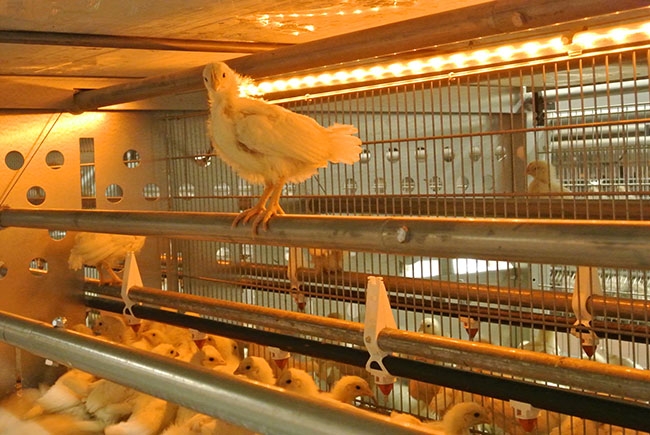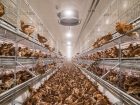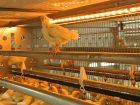
Layers and the future of rearing
By Treena Hein
Features Bird Management Production Alternative poultry housingExercise critical for pullets.
 Researchers have found pullets reared in complex systems are better able to negotiate them. They’ve also found rearing pullets with perches or in aviaries also increases bone health. PHOTO CREDIT: VOLITO
Researchers have found pullets reared in complex systems are better able to negotiate them. They’ve also found rearing pullets with perches or in aviaries also increases bone health. PHOTO CREDIT: VOLITOMost animal welfare studies relating to laying hens has focused on adult birds. However, with the alternative housing systems recommended by the new code of practice, researchers are now interested in the pullet rearing environment and how it can affect adults. Studies have found that the conditions chicks and pullets are exposed to early in life can have lifelong effects on the behaviour, health and welfare of laying hens.
First, consider temperament and behavioural tendencies of adult hens and pullets. Along with her colleagues, Dr. Teresa Casey-Trott, a poultry welfare scientist at the University of Guelph in Ontario, notes that the welfare of hens housed in aviaries, free-run systems and enriched cages is higher when the hens are calm and adapt effectively to changes in their environment.
Calm and adaptable hens with low fear levels also engage in less feather pecking and cannibalism, and there are fewer flock-scale injuries with these types of hens due to piling and smothering when birds are startled. Hens housed in multi-tier aviaries must also be able to negotiate complex environments with feed, water and nest boxes located on different levels, Casey-Trott notes. Her research has shown that if pullets have been reared in complex systems, they will be able to negotiate them to a stronger degree.
In addition to behaviourally preparing birds for the new housing systems in Canada, researchers have also found that rearing pullets with perches or in aviaries also increases musculoskeletal development and various measures of bone strength. Poor skeletal health has been a welfare concern for a long time, as it can lead to fractures, bone deformities, immobility, starvation and more. Casey-Trott notes that providing more opportunities for exercise during the pullet-rearing phase, a period of substantial musculoskeletal growth, offers a proactive approach to reducing osteoporosis by improving bone composition.
A recently published study done by Casey-Trott, D. Korver, M. Guerin, Victoria Sandilands, Stephanie Torrey and Tina Widowski examines just this topic. The team compared two groups of pullets reared in conventional cages and an aviary rearing system from day-old until 16 weeks of age. To measure muscle growth differences and bone quality characteristics, the team compared the keel bone and the muscles and long bones of the wings and legs. They found the length of the keel metasternum, caudal tip cartilage length and overall amount of cartilage was greater in the aviary-reared pullets, and their wing and breast muscle weights were also higher. However, their leg muscle weights were lower. Aviary pullets also had greater total bone density, total cross-sectional area and total bone mineral content in several major bones.
A second study looked at whether exercise during the pullet rearing phase reduces the prevalence of keel-bone damage throughout the adult laying period, as keel-bone fractures and deviations in laying hens are commonly seen in various housing systems. Casey-Trott and her colleagues looked at four comparison pullet groups reared in either conventional cages or an aviary system and then placed into either conventional or enriched cages as adults. The researcher says those reared in aviary systems had a lower percentage of keel bone fractures.
Housing options
Canada’s updated code of practice for the care and handling of laying hens and pullets suggests that hens housed in non-cage multi-tier systems or aviaries be sourced from non-cage rearing systems in which pullets had access to perches. The code recommends that producers source pullets that have been reared in similar facilities with similar practices to those that the birds will experience in the layer barn. The aim is to avoid, for example, sourcing pullets reared in cages if you have free-run barn housing.
There are a few different pullet-rearing housing systems on the market today. Some are similar to standard rearing cages but outfitted with perches. As the chicks grow, the front of the cage is opened to allow access to the barn and litter floors.
Other designs offer more vertical space to chicks within the starting cage and include different levels of perches and platforms during the first weeks of life. These cages are also opened as time progresses.
To find out the percentage of pullets being reared in different types of pullet housing in Canada – standard cage, standard cages outfitted with perches, cages where the front of the cage is opened to allow access to the barn and litter floors, designs that offer more vertical space to chicks within the starting cage and include different levels of perches and platforms and opened as time progresses and other options – Canadian Poultry asked Pullet Growers of Canada to weigh in. Chair Andy DeWeerd suggests that conventional pullet housing is around 85 to 90 per cent, and aviaries and loose housing make up the rest. “In a conventional [pullet] house there are no perches, while aviaries have perches and some loose houses also have perches.”
He says his members are meeting the demand for pullets raised in non-cage systems with perches. That said, “these systems cost more, so [pullet] producers are cautious to build one unless their customers want it.” He adds that there are plenty of pullet barns for non-cage-reared pullets for those producers that wish to follow the code recommendation that producers source pullets that have been reared in similar facilities with similar practices to those that the birds will experience in the layer barn. “But if the need arises we would have to build more.”
DeWeerd notes that the cost of alternate housing systems is much higher than conventional, not only to build but also to run. He concludes, “Being that the pullet industry does not receive their cost of production, it will be a challenge to try to get pullet farmers to build these systems.”
Print this page

